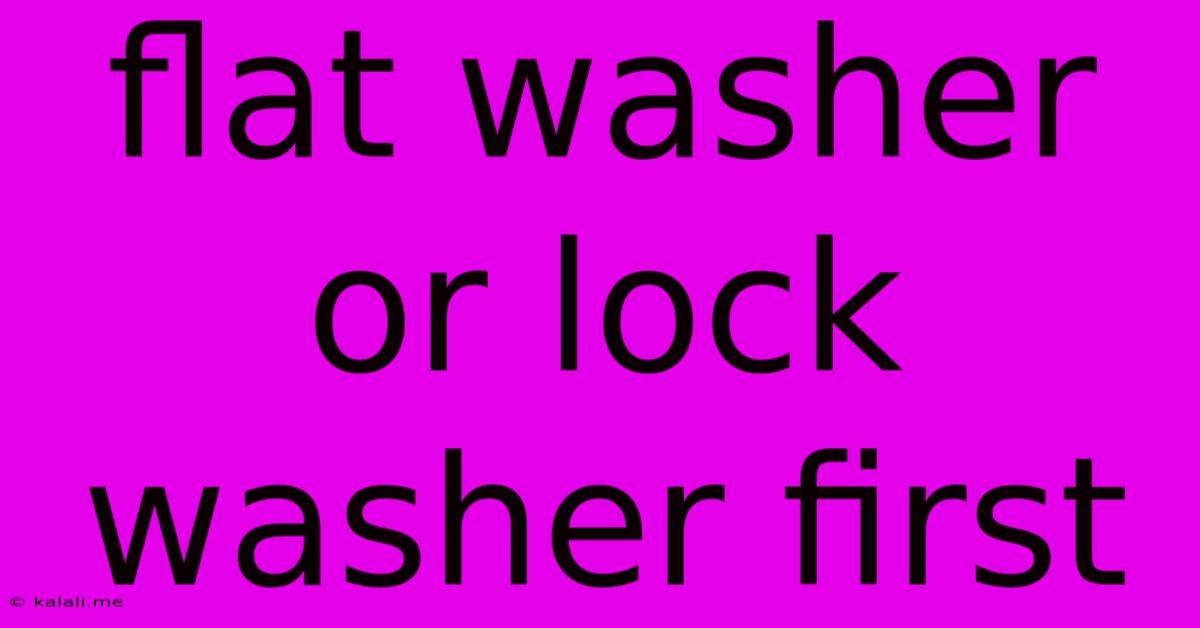Flat Washer Or Lock Washer First
Kalali
Jun 01, 2025 · 3 min read

Table of Contents
Flat Washer or Lock Washer First: The Definitive Guide
Meta Description: Unsure about the correct order for flat and lock washers? This guide clarifies the optimal sequence for various applications, ensuring secure and reliable fastening. Learn about the function of each washer type and how proper installation prevents future issues.
Installing fasteners might seem straightforward, but the seemingly insignificant detail of washer order can significantly impact the strength and longevity of your project. This article explores the age-old question: flat washer or lock washer first? The answer, as with most things, is "it depends." Let's delve into the nuances to ensure you're always using the right technique.
Understanding the Roles of Flat and Lock Washers
Before determining the sequence, understanding each washer's function is crucial.
-
Flat Washers: These simple, disc-shaped washers primarily distribute the clamping force of the nut or bolt head over a larger area. This prevents damage to the workpiece by reducing stress concentration. They provide a smooth, even surface, enhancing the seal and preventing galling (metal-to-metal wear).
-
Lock Washers: These washers are designed to prevent loosening of fasteners due to vibration or torque relaxation. Several types exist, including:
- Spring Lock Washers: These utilize a spring-like design to create friction and prevent loosening.
- Tooth Lock Washers: These feature teeth that dig into the mating surfaces, providing a more secure grip.
- Internal Tooth Lock Washers: These have internal teeth that grip the bolt shank.
Flat Washer then Lock Washer: The Common and Often Correct Approach
In most scenarios, the recommended order is flat washer, then lock washer, then nut or bolt head. This sequence offers several advantages:
- Even Force Distribution: The flat washer distributes the load evenly across the workpiece, preventing damage and ensuring a secure connection. The lock washer then engages to further enhance the connection's security.
- Protection of the Lock Washer: Placing the flat washer first protects the delicate teeth or spring of the lock washer from damage or deformation during installation. This prolongs the effectiveness of the lock washer.
- Improved Seal (in some cases): In applications where sealing is important, the flat washer provides a better surface for a gasket or sealant to adhere to, improving the overall sealing performance.
When to Reverse the Order (Exceptions to the Rule)
While the flat-then-lock sequence is generally preferred, there are exceptions:
- Thin Workpieces: If you're working with exceptionally thin material, placing the lock washer first might provide better grip and prevent damage to the workpiece. The lock washer's teeth or spring can provide better bite on the material, preventing the fastener from pulling through.
- Specific Manufacturer Recommendations: Always consult the manufacturer's instructions. Some specialized applications or fasteners may require a different washer order for optimal performance.
- Certain Lock Washer Designs: Some internal tooth lock washers are designed to be installed directly against the workpiece for maximum grip.
Choosing the Right Washer for the Job
The type of washer used is just as important as the order. Selecting the correct washer depends on factors like:
- Material: Consider the material of the workpiece and the fastener to select compatible washers that won't react adversely.
- Vibration Level: High vibration applications necessitate stronger lock washers.
- Load: The load on the fastener will dictate the size and material of the washers needed.
Conclusion: Prioritize the Application
While the standard practice is to place the flat washer before the lock washer, there are justifiable exceptions. Always consider the specific application, material properties, and manufacturer's recommendations to determine the optimal sequence. Careful consideration of these factors ensures a secure, reliable, and long-lasting fastening solution. Prioritize the longevity and security of your project by choosing the correct washers and installation method.
Latest Posts
Latest Posts
-
Delete Left 4 Dead 2 Beta From Windows
Jun 02, 2025
-
How Long Do Seed Potatoes Last
Jun 02, 2025
-
Can You Transplant Iris In Winter
Jun 02, 2025
-
15 Amp Outlet On 20 Amp Breaker
Jun 02, 2025
-
How To Find Basis For Null Space
Jun 02, 2025
Related Post
Thank you for visiting our website which covers about Flat Washer Or Lock Washer First . We hope the information provided has been useful to you. Feel free to contact us if you have any questions or need further assistance. See you next time and don't miss to bookmark.